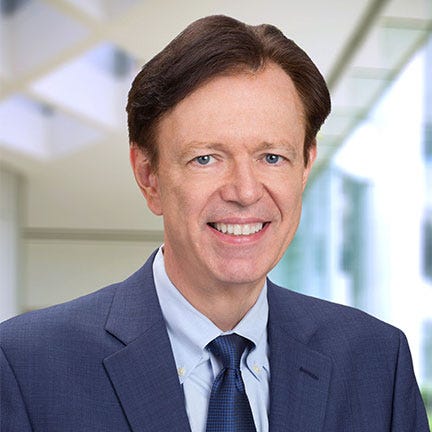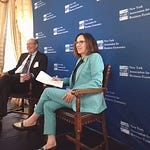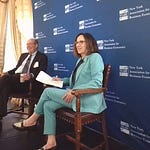Vincent Reinhart is a Federal Reserve pro, someone who knows the Fed and how it operates inside and out after spending 24 years of his early career both at the Board of Governors in Washington, where he rose to be the important position of head of the Division of Monetary affairs, and in key roles at the Federal Reserve Bank of New York. His keen Fed perspective has been honed working with financial market professionals on Wall Street and analyzing what monetary policy changes mean for investors, including roles at Morgan Stanley, culminating in his ascension to his role as Chief Economist at BNY Investments.
I especially wanted to talk with Vince after what happened in the past week. On Wednesday the FOMC - Federal Open Market Committe, that sets policy every six weeks or so - met and as expected did not make any change in policy. It did however issue new numbers for the SEPs - Summary of Economic Projections - and slightly altered its forecast for rate hikes this year, known as the DOTs. The message from Chair Jay Powell after the meeting at his regular press conference was that he is ready to wait and see what the economy does next.
In particular, Powell said that the Fed wants to see how much, or how little, tariffs push up inflation before making any kind of change in the Fed’s expected monetary policy path. The FOMC’s own SEP forecasts are for one of their key inflation measures to rise 3.1% this year, up from 2.8% in the Fed’s March forecasts. That’s one big reason why he’s ready to hold the key fed funds rate steady now.
Sound’s pretty straightforward. Until you bring in what two prominent Fed board governors said right after Powell sent his post-FOMC message. On the first day and hour that he could say anything about the Fed’s policy decision on Wednesday, Fed governor Chris Waller on Friday said he is ready to consider rate cuts — as soon as the July policy meeting, very different from what we heard from Powell at his post-meeting presser.
Then yesterday, Monday, Michelle “Mickey” Bowman, the Fed’s vice-chair for bank supervision, also said she could consider rate cuts in July, if inflation contiues to be under control. Meanwhile, several Fed bank presidents, and at least one Board governor, echoed Powell on their decision to wait and see what inflation does next for now. Clearly the FOMC is divided.
So dive in and hear what Vince has to say about all of this and more. It’s like listening to a lecture by one of your favorite professors: clear, simple, interesting. And important.
House panel did a good job on Powell Questioning- 00:01:58.
The House Financial Services Committee is dysfunctional, usually because it's so big. But this time it was pretty disciplined. There were actually questions about monetary policy, which isn't always the case, and everybody played within the playground rules. So it worked out pretty well. I thought.
On the Waller and Bowman post FOMC comments 00:02:51.260
…recognize how much the world has changed in the Federal Reserve a generation ago. In fact, the testimonies were big events. Volker and Greenspan made sure there was radio silence among their colleagues for the 2 weeks before and the week after, so that they got the platform alone, and if they were going to make news shift in the boat of monetary policy, it would be at the semiannual testimony. Lots of effort went into the monetary policy report and testimonies ran, you know, 2025 pages. Now the report is pretty much cut and paste from documents we've seen previously, and the testimony is 3 pages and get out of town. Why? Because they communicate so many other ways. There's the press conference. There's the expedited minutes, and there's the willingness of all of them to talk virtually all the time. Kind of knew that there would be FOMC speakers immediately after the meeting. Once the blackout curtain lifted because of the dot plot. It was a closer call to still do two. quarter point cuts in 2025. That meant there was a bigger range of opinions of FOMC participants, and they were going to make sure that their voice was heard. I think especially given that Chair Powell was down the middle of the road. Normally he's kind of dovish and optimistic. He pretty much played out what was in the summary of project economics.
A mixed message from Mr Powell 00:05:16.940
I would say that it was a mixed message for sure. Summary of economic projections is a big deal, because it's the only time they write down numbers. All other times they can get away with talking about labor markets roughly in balance or growth, near trend or inflation, rising but falling back. But they actually have to write down numbers each and every one of them. They don't do a great job of it. It's inconsistent assumptions. There's lots of things you can complain about the summary of economic projections. They arrived at it because of history and most of the time in press conferences the Chair spends, complains about its construction, but they write it down. Now, what's the key feature of the summary of economic projections? This time they still had two rate cuts in 2025. That was the dovish message. It was dovish because they nudged real GDP growth down and raised inflation. If you were just following a simple monetary policy rule that would have suggested actually a firmer stance of policy. It was something like 40 basis points, firmer, firmer policy rate appropriate for the end of the year. So if they were right in March, when they were saying two rate cuts, then they're wrong. In June, they say 2 rate cuts given what else they wrote down.
DOT plot not internally consistent 00:07:06.030
Yes, turning points are really tough, and they have been on a pause for a while, and so some of them get restive. And so the message from the dot plot twofold, one not really internally consistent. Given the rest of the forecast and 2, they disagree. they just got the median outcome that of two rate cuts, but it was mostly drifting upward. So, if you were in the camp of wanting rate cuts. you saw that your colleagues were shifting a little toward being somewhat more hawkish. and that the Chair, normally the upbeat guy who tends towards the Dovish side, was straight down the middle of the road during the press conference. You want to get out early. You want to paint the tape. You want to create a perception that the committee is really seriously talking about easing, because then every other speaker is dealing with fed funds, futures that have a bit more probability of ease priced in.
Committee looks a lot like Powell 00:09:18.150
So, with regard to the committee itself, one thing that Jay Powell said, often, early as Chair was, I was involved in the hiring of the 12 Reserve bank presidents. It is a committee that looks a lot like him, and so I think he does have a lot of sway with the group. However, the committee has changed over time, and I would note that it was two Trump Era appointment governors who are the ones straight out of the box arguing for prompter easing.
Tariffs: a complicated chain of events and actors 00:09:56.050
With regard to tariffs, there's a couple things to recognize. The one is supply chains are pretty complicated, and there is the cost of good imported goods at the dock. And then it's what we pay for in the store or online and in between are a lot of retail and wholesale margins. Transportation costs other taxes and duties. And so that's why there's a lot of slippage between the price of imports going up the cost of duties, and what we see in the final consumer's basket. The other point is the biggest unknown is the markup of the foreign provider. Do they take some of the tariff duty and pay it themselves. We could be in a situation in which measured import prices actually go down because they essentially pay their sample before the duty. They pay more of the duty. So it's complicated. The models that staff rely on.
The actual knock-on process is hard to pin down 00:11:12.130
Vincent Reinhart: or have a problem we don't have in our history. Such big increases in tariffs and such across the board increases in tariffs. So you should be suspicious of event studies, you know. Put a duty on washing machines. There's lots of opportunities to hike the price of washing machines when it's everything that goes up. Does that make it more willing or less willing for firms to pass through. They shouldn't be sure, however, generally the models that staff work with have the implication that when costs go up, prices do go up eventually, but it takes a while, and those lags are what they're waiting for. And Chair Powell remembers. Another time he was facing a supply shock and assumed that it would all be transitory, didn't work out that well.
Both supply and demand shifts in play in the labor market 00:12:48.090
So a couple things. The employment report isn't much of a leading indicator of basically a downturn is a sharp turn in activity, and you don't get much signal initial claims is important. Initial claims is a useful high frequency. quickly available indicator that does tend to move when there's a softening in activity, and, as you say, initial claims isn't sending that signal. How I'd characterize it is the growth of labor demand is unquestionably slowing in an environment in which, among the other things, the administration is doing is tightening immigration, enforcement, harder line at the border and outright deportations. Labor supply is also growing more slowly may actually be contracting right now in that environment, labor demand slowing is a risk importantly, because we may not be generating as much income. but which is important for spending, but labor demand slowing. When labor supply is slowing keeps the labor market in balance, and that's the core message from the employment reports overall this year. Labor market's roughly in balance.
Fed needs to combine quarters and look at the ‘first half’ 00:15:15.520
So I think they just have to average the 1st half of the year and not get too focused on the GDP data, because a lot of that is just give back from the decline in the 1st quarter, as importers brought forth a lot of of goods in anticipation of tariffs. The 1st quarter was an optical illusion, the second quarter. Corrects some of that. And so you're better off just averaging, and when you average it, you get activity. That's probably slowing a little bit and probably poised to slow a little bit more in the neighborhood, or probably below trend, but not that far below trend. By most assessments, like the Congressional Budget office levels above trend right now. So a little slowing. Is that not all that all that threatening.
There is demand momentum 00:16:16.110
I would say aggregate demand's got a lot of momentum that we are a whisker away from equity prices being at an all-time high financial conditions are easier than when they first embarked on the turn in monetary policy, and chances are we'll get fiscal stimulus from that one big, beautiful bill. So I think they probably assess spending, having momentum, slowing at a little bit below trend, keeping a labor market in balance that is being affected by supply constraints.
What if tariffs are not a supply shock? 00:16:59.090
And it's all about all about tariffs. I think you raise an important issue about tariffs. It's not necessarily a supply shock in the sense that what really, what really matters is the pass-through of tariffs to import prices. If foreign producers eat the duties, actually pay the duties and don't pass them through to import prices. In fact, that means we're getting government revenue from abroad. That's not exactly bad for aggregate demand. and it's only if they pass through most or all of the duty that we're basically taxing ourselves and restraining demand for imports. So it's not a straight supply shock. And the trick here is, if it turns out that there isn't as much price effect
of the tariff hike. It probably means that demand is going to be better, better as well. And so the net implication for the Federal Reserve is is nuanced.
Powell wants to go out on a winning streak 00:19:37.090
I would suspect that <Powell> wants to leave with inflation at or around goal. and that he doesn't want to be known as as the chair. Who who missed it, who leaned the wrong way after the pandemic and didn't correct the mistake. So I think that that part of it suggests that he wants to be sure to be able to declare victory. The other part is, Look, the irony of the White House. Criticism of the Federal Reserve and the various personal attacks on the Fed Chair is boy probably makes them less. Have to think twice about doing something that makes the criticizer look right.
Will the Fed learn lessons from earlier Post Covid mistakes? 00:21:27.450
I think in retrospect they might want to take back some of the easing. The speed to which they did. It wasn't really convinced they had a good rationale to start from the gate so quickly. But you know, in retrospect they'd also say, Gee! We wish we started in 2022, and in hindsight really is helpful. At this point, I think Chair Powell would rightfully say. You know, markets mostly got it. They had an expectation of what the Fed was going to do, and the two-year note moved in advance of the policy rate. And so the Fed acted pretty consistently. Would you like to shape the sand off the rough edges of the path for the Federal funds rate target? Yeah. Sure love to get that chance. But they don't have it. And and yeah, so I think that what they should do is learn from that. And what were the two messages we just meant they didn't start tightening soon enough, and they left firmness too early. They should be thinking about that in 2025.
The Previous framework was a problem 00:23:24.430
Vincent Reinhart: Why, yeah, what's the argument, Kathleen? The argument is, they were impaired by the previous Framework Review. That made them slow to start tightening because they had convinced themselves that inflation was mean-reverting that they could be inflation averagers in their target, and that they could be one-sided worry more about slack than they do about inflation. The problem with the previous Framework Review. Is it institutionalized 20 years of good economic performance on that, when there was a big force for disinflation goods. Inflation was only a half percent.
Not clear where Fed takes this next under the new framework 00:24:15.140
Because of globalization… and if 30% of your gold basket is only half percent, then you can push at the margins on the other 70%. You could run the market a little hot. That's what they did. And that's what they thought they could still do. Given a supply shock that upended that 20 years. That was a mistake. They have to correct that part of the mistake in the in the new Framework Review. But remember, they've already taken off the table any consideration of the price goal. They got a 2% target.
Fed models internalize external geopolitical events 00:25:25.560
So the syllogism is that monetary policy has to be made on a forecast. If X matters for the forecast, it matters for monetary policy. And there's a lot of stuff that goes in X, including geopolitical events. So yes, they worry about those events impinging on the settled order of what they're doing. They mostly think about it exactly as you say, how it shows through the variables in their model. What does it do to oil prices? What does it do to the risk premium on capital assets? So they look for the footprint of the event. They don't spend their time trying to second. Guess the geopolitics. They take that as given. They take a consensus assumption about it, and then try to figure out the footprint on the economy. So it does matter. I think, for instance, it was more material to expectations of policy in 2025 that oil prices went down 5 and a half percent. Then Jay Powell testified on the same day. So yeah, it matters. There's nothing they can do about it, though.
Prospect of July rate cut…it’s low 00:27:01.110
I think it's pretty low. Something would have to roll over. and it would have to on on the, on the market side or the economy side. We usually don't turn that quickly, and that even if we got really good news on inflation, it would still be hanging over us that there's still more tariffs to come, more tariff effects to come. As long as that's hanging there in the back, you know, as a future event, it's tough for them to move quickly.
VINCENT REINHART
Chief Economist & Macro Strategist
BNY INVESTMENT INVESTMENTS
Vincent is the firm's Chief Economist and Macro Strategist. In this role, he is responsible for developing views on the global economy and making relative value recommendations across global bond markets, currencies and sectors.
Previously, Vincent served as the Chief US Economist and a managing director at Morgan Stanley. For the prior four years, he was a resident scholar at the American Enterprise Institute (AEI). Vincent also spent 24 years at the Federal Reserve, holding several roles including Director of the Division of Monetary Affairs and Secretary and Economist of the Federal Open Market Committee (FOMC). His responsibilities at the Federal Reserve included directing research and analysis of monetary policy strategies and the conduct of policy through open market operations, discount window lending and reserve requirements. Prior to these roles, he was the principal liaison with the domestic desk at the Federal Reserve Bank of New York and was responsible for preparing a document outlining policy alternatives for each FOMC meeting. He was Deputy Director in the Division of International Finance and Associate Economist of the FOMC and spent five years at the Federal Reserve Bank of New York in both the domestic and international research departments.
His academic publications primarily concern the conduct of policy and issues related to the monetary transmission mechanism as well as an analysis of alternative auction techniques and Treasury debt management. After an undergraduate training at Fordham University, he received graduate degrees in economics at Columbia University.













Share this post